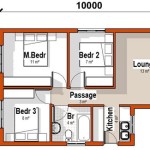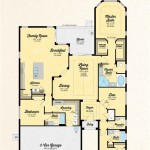Two-Bedroom House Building Plan: A Comprehensive Guide
A two-bedroom house building plan represents a pragmatic and popular choice for a wide array of homeowners. These plans are suitable for small families, couples, single individuals, and even those looking to downsize. The appeal of a two-bedroom house lies in its balance of affordability, manageable size, and functional living space. Successful implementation of a two-bedroom house building plan requires careful consideration of various factors, including floor plan design, cost estimations, local building codes, and contractor selection. This article provides a comprehensive overview of key aspects to consider when embarking on a two-bedroom house construction project, emphasizing critical decision-making points.
The initial phase involves determining the specific needs and preferences of the homeowner. This includes defining the desired square footage, architectural style, layout configuration, and any specific features that are considered essential. Prioritization is crucial, as budgetary constraints and land limitations may necessitate compromises. Detailed needs assessment helps to guide the subsequent design process and ensures that the finished house aligns with the homeowner's lifestyle and long-term requirements.
Key Point 1: Floor Plan Optimization
Effective floor plan design is paramount for maximizing the utility and comfort of a two-bedroom house. Space optimization is crucial, particularly given the relatively smaller footprint compared to larger homes. A well-designed floor plan will incorporate efficient traffic flow, adequate storage solutions, and a functional layout that caters to the daily routines of the occupants.
One fundamental aspect of floor plan design is the arrangement of the living spaces. Ideally, the living room, dining area, and kitchen should be integrated into an open-concept layout to create a sense of spaciousness and facilitate social interaction. This configuration also allows for better natural light distribution throughout the house. Careful consideration should be given to the dimensions of these spaces to accommodate furniture and appliances comfortably.
The placement of the bedrooms is another essential factor. For optimal privacy, it is generally recommended to locate the bedrooms away from the main living areas. A master bedroom with an en-suite bathroom is a popular feature, offering convenience and exclusivity. The second bedroom can serve as a guest room, home office, or a children's room, depending on the homeowner's requirements. Adequate closet space is a necessary component for both bedrooms.
Bathrooms should be strategically located for convenient access from both bedrooms and living areas. A single full bathroom can suffice for a two-bedroom house, but adding a half-bath (powder room) near the entrance or living area can enhance convenience, particularly for guests. The bathroom design should incorporate efficient use of space and durable, easy-to-clean materials.
Storage solutions are often overlooked in smaller homes, but they are critical for maintaining an organized and clutter-free living environment. Built-in cabinets, shelves, and closets can maximize storage space without encroaching on the living areas. Utilizing vertical space is also an effective strategy. Consider incorporating storage solutions in hallways, under staircases, and in the attic or basement, if applicable.
Natural light and ventilation are crucial for creating a comfortable and healthy indoor environment. Strategically placing windows and doors can maximize natural light penetration and promote cross-ventilation. Consider the orientation of the house to optimize sunlight exposure and minimize heat gain during the summer months. Skylights and solar tubes can also be used to enhance natural lighting in areas that receive limited sunlight.
Finally, circulation paths should be carefully planned to ensure smooth and efficient movement throughout the house. Avoid creating narrow hallways or dead-end spaces that can feel cramped and awkward. Wide doorways and hallways can accommodate wheelchairs and other mobility aids, making the house more accessible for people with disabilities.
Key Point 2: Budgeting and Cost Management
Developing a realistic budget is critical for the success of any construction project, and a two-bedroom house is no exception. Accurate cost estimation is important to avoid financial surprises and ensure that the project remains within the homeowner's financial means. A comprehensive budget should encompass all aspects of the construction process, including design fees, permits, materials, labor, and contingencies.
The first step in budgeting is to obtain detailed bids from multiple contractors. These bids should itemize the costs of materials, labor, and other related expenses. It is essential to compare bids carefully and choose a contractor that offers a fair price without compromising on quality. Checking references and verifying the contractor's credentials is also crucial to ensure that they are qualified and reliable.
Material selection is a significant factor in determining the overall cost of the project. Different types of materials vary widely in price and quality. Making informed decisions about material choices can help to control costs without sacrificing durability and aesthetics. Consider using cost-effective alternatives for certain materials, such as laminate flooring instead of hardwood or vinyl siding instead of brick. However, it is important to prioritize quality and longevity, especially for critical components like the foundation, roofing, and plumbing.
Labor costs represent a significant portion of the overall budget. The cost of labor varies depending on the location, the skill level of the workers, and the complexity of the project. Obtaining multiple bids from different contractors can help to ensure that you are getting a competitive price for labor. Consider hiring subcontractors for specialized tasks, such as electrical work and plumbing, to ensure that the work is done correctly and safely.
Permit fees and inspection costs can add to the overall budget. Building permits are required for most construction projects, and the cost of these permits varies depending on the jurisdiction. Inspections are conducted throughout the construction process to ensure that the work complies with building codes and safety regulations. Budgeting for these fees is essential to avoid delays and penalties.
Contingency funds are crucial for covering unexpected expenses that may arise during construction. It is recommended to set aside at least 10% of the total budget as a contingency fund. This fund can be used to cover unforeseen costs, such as material price increases, unexpected site conditions, or changes to the design.
Financing options should also be considered. Mortgages, construction loans, and personal savings are common sources of funding for home construction projects. Explore different financing options and choose the one that best suits your financial situation. Be sure to factor in interest rates, loan fees, and repayment terms when making your decision.
Key Point 3: Adherence to Building Codes and Regulations
Compliance with local building codes and regulations is paramount for ensuring the safety and structural integrity of the house. Building codes are designed to protect the health and safety of the occupants and ensure that the house meets minimum standards for construction quality. Ignoring these codes can lead to serious consequences, including fines, legal action, and even the demolition of the house.
The first step in ensuring compliance is to familiarize oneself with the specific building codes and regulations that apply to the location. These codes vary depending on the jurisdiction and may address various aspects of construction, including foundation design, framing, electrical wiring, plumbing, and fire safety. Local building departments can provide information on the applicable codes and regulations.
Hiring a qualified contractor who is familiar with the local building codes is essential. A competent contractor will ensure that the work is done in accordance with the codes and that all necessary inspections are passed. They will also be able to advise on any changes or modifications that may be required to comply with the codes.
Obtaining the necessary permits is a crucial step in the construction process. Building permits are required for most construction projects, and they are designed to ensure that the work is inspected and approved by local authorities. Applying for permits before starting construction can avoid delays and penalties. The permit application process typically involves submitting detailed plans and specifications for the project.
Inspections are conducted throughout the construction process to ensure that the work complies with building codes and safety regulations. These inspections are typically performed by local building inspectors. It is important to be present during inspections and address any issues that are identified by the inspector promptly. Failure to pass an inspection can result in delays and additional costs.
Energy efficiency is an increasingly important consideration in modern building codes. Many jurisdictions now require new homes to meet certain energy efficiency standards. This may involve installing energy-efficient windows, insulation, and appliances. Compliance with energy efficiency codes can help to reduce energy consumption and lower utility bills.
Accessibility requirements are also addressed in building codes. These requirements are designed to ensure that new homes are accessible to people with disabilities. Common accessibility features include ramps, wider doorways, and accessible bathrooms. Compliance with accessibility requirements can make the house more comfortable and convenient for people of all abilities.
Fire safety is a critical aspect of building codes. Fire safety requirements may include installing smoke detectors, fire-resistant materials, and fire sprinklers. Compliance with fire safety codes can help to protect the occupants of the house in the event of a fire.
In essence, a meticulously planned two-bedroom house building plan considering these factors will result in a dwelling that is both functional and aesthetically pleasing, meeting the homeowner's needs while adhering to all applicable regulations and staying within budget. Careful planning and execution are essential to achieving a successful project.

Two Bedroom Small House Plan Cool Concepts Design Plans

2 Bedroom House Plans For Stylish Homes Ck

2 Bedroom House Plans Monster

2 Bedroom House Plan Examples

Country Style House Plan 2 Beds 1 Baths 1007 Sq Ft 44 158 Small Floor Plans Tiny

2 Bedroom House Plan Examples

Unique Small 2 Bedroom House Plans Cabin Cottage

2 Bedroom House Plans For Stylish Homes Ck

Modern 2 Bedroom House Plan 61custom Contemporary Plans Floor Courtyard

12 Simple 2 Bedroom House Plans With Garages Houseplans Blog Com
Related Posts








